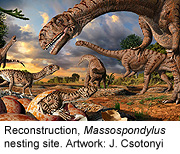
WEDNESDAY, Jan. 25 (HealthDay News) — Researchers who found the earliest known dinosaur nesting site say it offers significant clues about the evolution of complex reproductive behavior in early dinosaurs.
The 190-million-year-old site in South Africa is 100 million years older than previously known nesting sites. It contains clutches of eggs of the prosauropod dinosaur Massospondylus, a relative of the giant, long-necked sauropods of the Jurassic and Cretaceous periods. Many of the eggs contain embryos.
There are also tiny dinosaur footprints, which provide the oldest known evidence that hatchlings remained at the nesting site long enough to at least double in size.
At least 10 nests, each with up to 34 round eggs in tightly clustered clutches, have been found at several ground levels at the site. The fact that there are nests at different levels in the sediment indicates that the dinosaurs returned repeatedly to the site and likely gathered in groups to lay their eggs.
This is the oldest known evidence of such behavior in the fossil record, according to Robert Reisz, a paleontologist and professor of biology at University of Toronto.
The mothers were 6 meters long and the eggs were about 6 to 7 centimeters in diameter. The highly organized nature of the nests suggests that the mothers carefully arranged the eggs after they laid them.
“The eggs, embryos and nests come from the rocks of a nearly vertical road cut only 25 meters long,” Reisz said in a university news release. “Even so, we found ten nests, suggesting that there are a lot more in the cliff, still covered by tons of rock. We predict that many more nests will be eroded out in time as natural weathering processes continue.”
The research appears in this week’s issue of the Proceedings of the National Academy of Science.
More information
The Smithsonian as more on Massospondylusdinosaurs.

